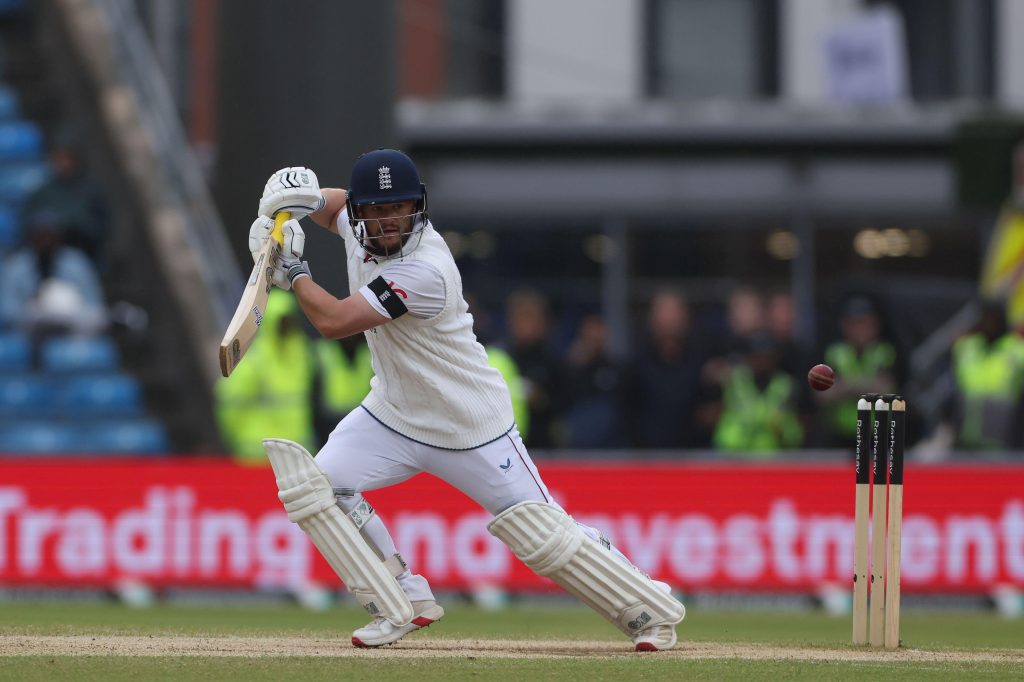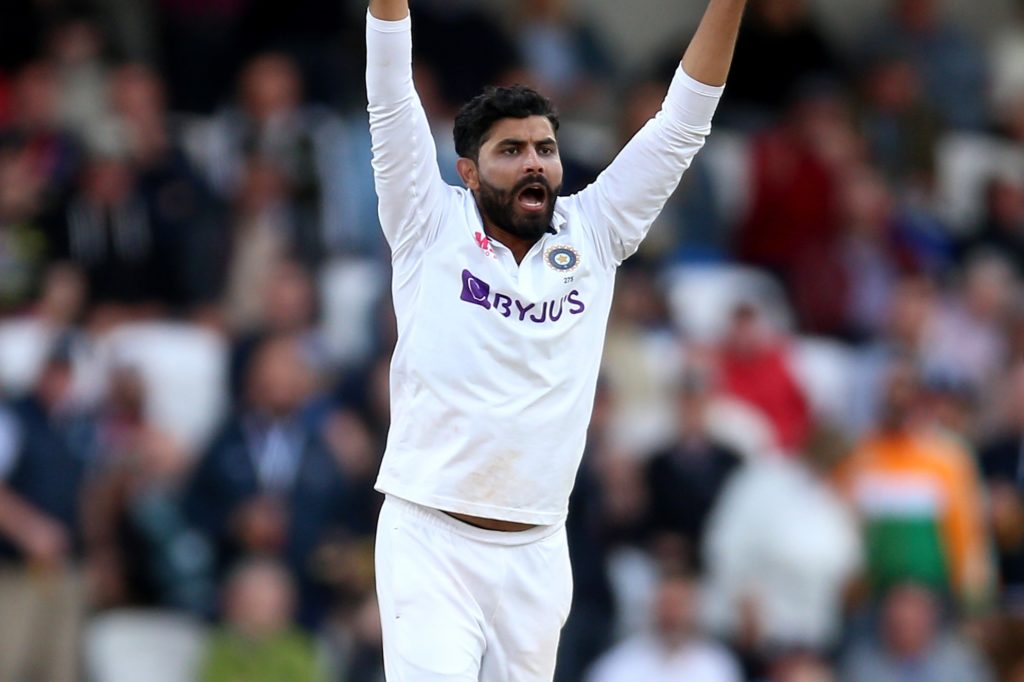After a week off following the Lord’s epic, in which the hosts went 2-1 up, the five-Test series remains evenly poised ahead of Old Trafford on Wednesday.
At the halfway mark, fans have already been treated to a platter of record-breaking performances from both sides.
It is a series that has lived up to its billing, and one that has observed a profound clash in ideologies.
While Ben Stokes and his galvanised side sit ahead in the scoreline, Shubman Gill and Gautam Gambhir’s up-and-comers remain in hot pursuit of the Anderson-Tendulkar trophy.
In anticipation of the fourth Test, Cricket Paper writer Mohan Harihar looks back at the accomplishments of both teams to stitch together a combined England-India XI of the series so far.
Want to own a piece of cricket history? Check out Firma Stella’s exclusive range of signed cricket memorabilia from legendary players. Perfect for collectors and fans alike, each item comes with a certificate of authenticity!
1. KL Rahul (runs: 375, highest score: 137, average: 62.50, strike rate: 55.97, 100s/50s: 2/1)
Silky-smooth, assured and old-fashioned, KL Rahul has been the standout opener across both sides so far.
Technically proficient against the moving new ball – the solitary junctures at which seam bowlers have been threatening on flat pitches – Rahul’s low-risk, high-reward approach at the top of the order has been essential for India’s success as a batting unit.
His 137 at Headingley and 100 at Lord’s were near-flawless, navigating the initial threat of the hard new ball before settling in to establish the platform for his free-flowing teammates.
In a series that has witnessed the brashness of Bazball and the eccentricities of Rishabh Pant, Rahul remains a pillar of stability.
2. Ben Duckett (runs: 271, highest score: 149, average: 45.16, strike rate: 80.65, 100s/50s: 1/1)
At Headingley, England’s energiser and pocket rocket, Ben Duckett, showed the world why he is one of Test cricket’s most valuable openers.
His calculated, match-winning fourth-innings 149 – in the face of an in-form Jasprit Bumrah – arguably remains the innings of the series so far.
He has suffered a lean patch since then with a high score of only 25 across Edgbaston and Lord’s. However, his no-nonsense contributions serve as the ideal foil for KL Rahul, creating a compelling yin-yang opening partnership.


3. Shubman Gill (runs: 607, highest score: 269, average: 101.16, strike rate: 71.83, 100s/50s: 3/0)
At Edgbaston, Gill rewrote the history books with a once-in-a-lifetime batting display.
His 269 and 161 was the first instance a batter notched up a double ton and 150 in the same match, and the aggregate of 430 runs sits second only to Graham Gooch (456).
Quite simply, India’s captain is the man all other batters are chasing this series.
Gill also has in his sights a 95-year-old record that looks ripe for the taking: the most runs scored by a batter in a single series (974, scored by Sir Don Bradman in the 1930 Ashes series).
Given his red-hot form and the playing surfaces we have seen, you would not bet against it.
At a position one higher than we have seen in this series, India’s ‘next big thing’ slots in at number three. However, given the batter-friendly surfaces this should not be a problem.
4. Joe Root (runs: 253, highest score: 104, average: 50.60, strike rate: 50.70, 100s/50s: 1/1)
Despite a relatively quiet start to the series owing to his own lofty standards, Root’s presence has been felt when his side has needed him the most.
His fourth-innings 53* at Headingley steadied the chase to see England home.
In contrast, his 104 and 40 at Lord’s – by no means a batting nirvana as was the case at Headingley and Edgbaston – were prime examples of why he now rubs shoulders with the all-time greats in the record books.
With runs at Lord’s to get him going in the series, along with only 120 runs separating him from becoming the second-highest run scorer in Test history, do not be surprised if Root proceeds to make the last two Tests of the series his own.
5. Rishabh Pant (runs: 425, highest score: 134, average: 70.83, strike rate: 78.41, 100s/50s: 2/2)
Even the term ‘rambunctious’ is too tame a descriptor for the antics of Rishabh Pant in this series.
Cricket is a sport that, at times, develops a limerence for hyperbole. Yet, in Pant’s case, he is slowly and credibly staking a claim to rival Adam Gilchrist as a full-time Test wicketkeeper-batter, with this series adding to the mounting evidence in his favour.
Pant’s twin tons at Headingley saw him become only the second wicketkeeper behind Andy Flower to achieve this feat.
The innings captured the unsullied spirit of the man: outlandish strokeplay, an endearing irreverence to Test cricket’s commandments and a century celebration more out of the Premier League playbook than the MCC coaching manual.
At number five, Pant is the biggest trump card with the bat across both sides. With the gloves, he has had a modest series with seven dismissals and some laboured displays.
But in this side, he will feature exclusively as a batter.
6. Ravindra Jadeja (runs: 327, highest score: 89, average: 109.00, strike rate: 52.57, 100s/50s: 0/4, overs bowled: 99.0, wickets: 3, best bowling: 1/29, economy: 3.34, average: 110.33)
Ravindra Jadeja remains a constant in an Indian team that is in the midst of a monumental metamorphosis in both playing personnel and identity following the retirements of Virat Kohli, Rohit Sharma and Ravichandran Ashwin.
His batting has gone unnoticed with the belligerence and boisterousness surrounding him, but he has quietly notched up four consecutive 50s.
His gargantuan fourth-innings effort of 61* off 181 balls at Lord’s, which dared to pull off the unthinkable, epitomises his role in this team.
He is the glue that holds together the dashers in the top five and the incisive seamers in the tail.
Admittedly, his efforts with the ball have been underwhelming, particularly at Headingley on the final day.
That said, given the inexperience of spin bowlers around him across both sides, and the greater influence pace bowlers have generally had over spin on flat pitches, he stays the first-choice spinner for this XI.


7. Jamie Smith (wk) (runs: 415, highest score: 184*, average: 103.75, strike rate: 85.92, 100s/50s: 1/2, dismissals as wicketkeeper: 14)
England’s new kid on the block continues to grow in stature. Still young at only 25, his demeanour and decision-making at the crease have resembled those of a seasoned veteran.
At Edgbaston, his 184* showcased a blueprint for Bazball that the rest of the batting line-up would do well to emulate.
It was not reckless, but aggressive enough to stamp his authority on India’s bowlers and rejuvenate the England innings in a way they have grown accustomed to.
With five scores above 40 from six innings, Smith’s consistency in counter-attacking strokeplay continues to be a headache for the Indian team.
Behind the stumps, Smith has largely gone unnoticed, typically the barometer for a sound gloveman. And with 14 dismissals under his belt, he is also the wicketkeeper in this combined XI.
8. Ben Stokes (c) (runs: 163, highest score: 44, average: 27.16, strike rate: 42.55, 100s/50s: 0/0, overs bowled: 105.0, wickets: 11, best bowling: 4/66, economy: 3.08, average: 29.45)
Lionhearted, relentlessly optimistic and tactically astute, Ben Stokes is the captain of this side.
With the bat, he no longer delivers the consistent scores he once did. Additionally, from a distance at least, the optimal batting tempo for him in this side continues to elude him.
Nevertheless, he has contributed valuable runs down the order, namely at Lord’s (44 and 33).
Stokes’ primary role in this side will be as a strike bowler. Following two severe hamstring injuries over the last year, and an extensive surgery to resolve his most recent setback, his body is successfully adjusting to the rigours of Test cricket again.
Bowling regularly at 85mph (and on occasion touching 87mph), he has created wicket-taking opportunities on pitches designed to pacify and placate even the deadliest of bowlers, bar Jasprit Bumrah.
Add to this his killer instinct in the field – most notably on show with his run-out of Rishabh Pant on the verge of lunch on day three at Lord’s – and his natural strategic brain, Stokes’ presence across all facets of the game is his unique selling point in the twilight of his career, and in this XI.


9. Brydon Carse (overs bowled: 117.0, wickets: 9, best bowling: 3/80, economy: 3.70, average: 48.11)
One of England’s newest additions, Brydon Carse is quickly becoming a go-to for his captain.
On unforgiving pitches, Carse has gallantly bounded in during all three Test matches.
There have been slivers of promise of a bowler capable of being a handful with the new ball, particularly with his double-wicket burst in the final hour of day four at Lord’s.
Crucial runs have also flowed from the blade of Carse, including 56 at Lord’s, 38 at Edgbaston and 22 at Headingley.
His ability to ally tempered aggression with unflappable levels of effort for his captain has been commendable, making Carse a useful number nine in this team and one half of the new-ball attack.
10. Jasprit Bumrah (overs bowled: 86.4, wickets: 12, best bowling: 5/74, economy: 2.90, average: 21.00)
If Jasprit Bumrah came into this showpiece event as the number one bowler in the world and with a reputation for fast-bowling artistry, this series has only reinforced his generational talents.
With two five-wicket hauls in the two games he has featured in, Bumrah has been a class above everyone else.
Of all bowlers to have played at least two games this series, he is the only bowler to average less than 28.00 (21.00).
His 5-83 at Headingley was a masterclass from a bowler equipped with every skill and trick in the book, executed in a manner that shunned even the most placid of batting conditions.
Curiously, despite his own brilliance, India have ended up on the wrong side of the result in both games he has played.
Irrespective of this paradox, Bumrah’s unparalleled mastery places him easily as the other opening bowler of this XI.
11. Mohammad Siraj (overs bowled: 109.0, wickets: 13, best bowling: 6/70, economy: 3.81, average: 32.00)
In a series littered with sun-soaked flat pitches, there has been no better man to rise to this challenge than Mohammad Siraj.
A pantomime villain among England audiences, he is far from that with ball in hand for India.
No matter the situation of the game or the fatigue in his bones, Siraj has charged in ball after ball, spell after spell, and session after session.
And with 13 wickets to his name, he sits atop the leading wicket-takers’ list.
His 6/70 led India’s charge at Edgbaston who, along with Akash Deep, proved to be the difference between the two sides in that Test.
Jovial, passionate, zestful and unquestionably determined, Siraj rounds off the seam attack for this team.
By Mohan Harihar
READ MORE: England ready to ‘get stuck in’ to India again after Lord’s clashes – Harry Brook
(Except for the headline, this story has not been edited by PostX News and is published from a syndicated feed.)

